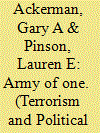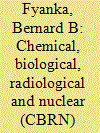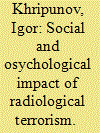|
|
|
Sort Order |
|
|
|
Items / Page
|
|
|
|
|
|
|
| Srl | Item |
| 1 |
ID:
132371


|
|
|
|
|
| Publication |
2014.
|
| Summary/Abstract |
In recent years, much of the literature on terrorist pursuits and use of unconventional weapons has focused on al-Qaeda and other Islamic extremist groups. Some scholars posit lone actors may differ from organizations when it comes to the observation that larger organizations are more likely to engage in chemical, biological, radiological, and nuclear (CBRN) activity, but leave this as an open question because of a prior lack of data on lone actors. Furthermore, new technologies and expanding networks may also spawn more deleterious lone actors, including what have been referred to as "super-empowered individuals." This article utilizes the Profiles of Incidents Involving CBRN by Non-State Actors Dataset and the Radiological and Nuclear Non-State Actors Database to illustrate the characteristics of CBRN pursuit by lone wolves and autonomous cells over time. Initial findings confirm the general perceptions that, historically, lone actors have engaged in cruder, smaller scale, and less frequent CBRN plots and attacks than their formal terrorist organization counterparts, but suggest that such actors do present a genuine threat, at least in terms of the potential for mass disruption. Additionally, while they share several similarities with more formal organizations, lone actors and autonomous cells tend to be motivated less by collective religious or ethno-nationalist concerns than larger organizations, focusing more on narrow or solipsistic drivers. Lone actors and autonomous cells also appear to largely calibrate their CBRN ambitions to their capabilities and their CBRN actions tend to receive better media coverage than formal terrorist organizations.
|
|
|
|
|
|
|
|
|
|
|
|
|
|
|
|
| 2 |
ID:
172053


|
|
|
|
|
| Summary/Abstract |
Terrorists combining motivations and capabilities to conduct significant chemical, biological, radiological, or nuclear (CBRN) attacks are, logically and empirically, outliers. Certain characteristics of radical environmentalism heighten the risk of such outliers. The majority of even radical environmentalists embrace nonviolence. Those who turn violent mostly do so in limited ways due to a combination of motivations and capabilities. Fringe elements are motivated to commit large-scale—including CBRN—violence, but are mostly constrained by capability. Yet eco-radicalism also draws more capable adherents. If serious CBRN terrorism attacks occur—a risk about which analysts differ markedly—radical environmentalist fringe actors are plausible perpetrators.
|
|
|
|
|
|
|
|
|
|
|
|
|
|
|
|
| 3 |
ID:
172095


|
|
|
|
|
| Summary/Abstract |
The post-Cold-War collapse of the Soviet military-industrial complex has enabled the rapid global proliferation of nuclear weapons and fissile material, thereby escalating the possibilities of non-conventional nuclear attacks. Such attacks have become more likely with the emergence of very powerful terrorist groups like Boko Haram and others around the world. Over 1,800 metric tons of nuclear material is still stored in poorly secured facilities in more than 25 countries. The International Atomic Energy Agency (IAEA) as at December 2015 had recorded in their trafficking database a total of 2,889 incidents involving losses, thefts and attempts to traffic fissile material across international borders. Boko Haram may also engage with radiological or biochemical ‘dirty bombs’, which are easier to make. With no less than 48 reported incidences of biochemical attacks since 1900, it is likely that Boko Haram may switch tactics, especially considering the lack of biochemical detection protocols in Nigeria’s counterterrorism strategy and also the inconsistency in public and private sector collaboration. This new reality calls for a recalibration of Nigeria’s counterterrorism protocols to accommodate the anticipated threat. The paper thus highlights policy considerations and advocates new directions.
|
|
|
|
|
|
|
|
|
|
|
|
|
|
|
|
| 4 |
ID:
175741


|
|
|
|
|
| Summary/Abstract |
The threat of chemical, biological, radiological and nuclear (CBRN) terrorism is widely attributed to collective actors based on a religious ideology, e.g. globally operating Salafi-jihadist groups like al-Qaeda or ISIL. Only limited attention has been given to the CBRN threat of violent domestic extremists in general or far-right terrorists specifically. Nevertheless, a number of incidents involving far-right activists and CBRN agents in Western countries are known to the public, even though these have had comparatively little impact on public threat perception. This study systematically collected public information about far-right CBRN incidents to identify their main characteristics. The authors were able to identify 31 incidents in Western countries since 1970, which display features contrary to generally assumed forms of CBRN terrorism. Far-right CBRN terrorism appears to be predominantly a lone-actor phenomenon oftentimes involving middle-aged and comparatively well-educated male perpetrators, mostly motivated by non-religious forms of far-right ideology (i.e. neo-Nazism, non-religious white supremacism) and indiscriminately targeting victims. Overall, far-right actors attempting to weaponize CBRN agents have been few and generally technically inept. However, the characteristics of the plots pose potential challenges for effective counter-measures and intervention, should the number of actors or the technical sophistication of plots increase in the future.
|
|
|
|
|
|
|
|
|
|
|
|
|
|
|
|
| 5 |
ID:
075779


|
|
|
|
|
| Publication |
2006.
|
| Summary/Abstract |
The July 2005 terrorist attacks in London demonstrated the resilience of Western society in the face of low-level conventional terrorism. But the psychological damage from the London bombings would likely pale next to the severe, unpredictable, long-lasting effects of a radiological attack. One unique hazard of radiation exposure beyond the obvious physiological effects is that it is colorless, odorless, and tasteless, making it difficult for ordinary citizens to evaluate, quantify, and rationally understand the dangers confronting them. Radiological weapons stand out among the tools available to terrorists for their capacity to inflict far-reaching psychological damage to civilian populaces well beyond the immediate victims. A possible solution to mitigate the psychological consequences is to build a "resilience culture," an interlocking set of beliefs, attitudes, approaches, and behaviors that help people fare better in any disaster or extraordinary circumstance. The "all-hazards approach," which emphasizes the identifiable similarities among the "disaster triad"-that is, natural, accidentally man-made, and intentionally man-made disasters-extends to acts of terrorism and could help demystify the fears associated with radiological terrorist weapons.
|
|
|
|
|
|
|
|
|
|
|
|
|
|
|
|
|
|
|
|
|